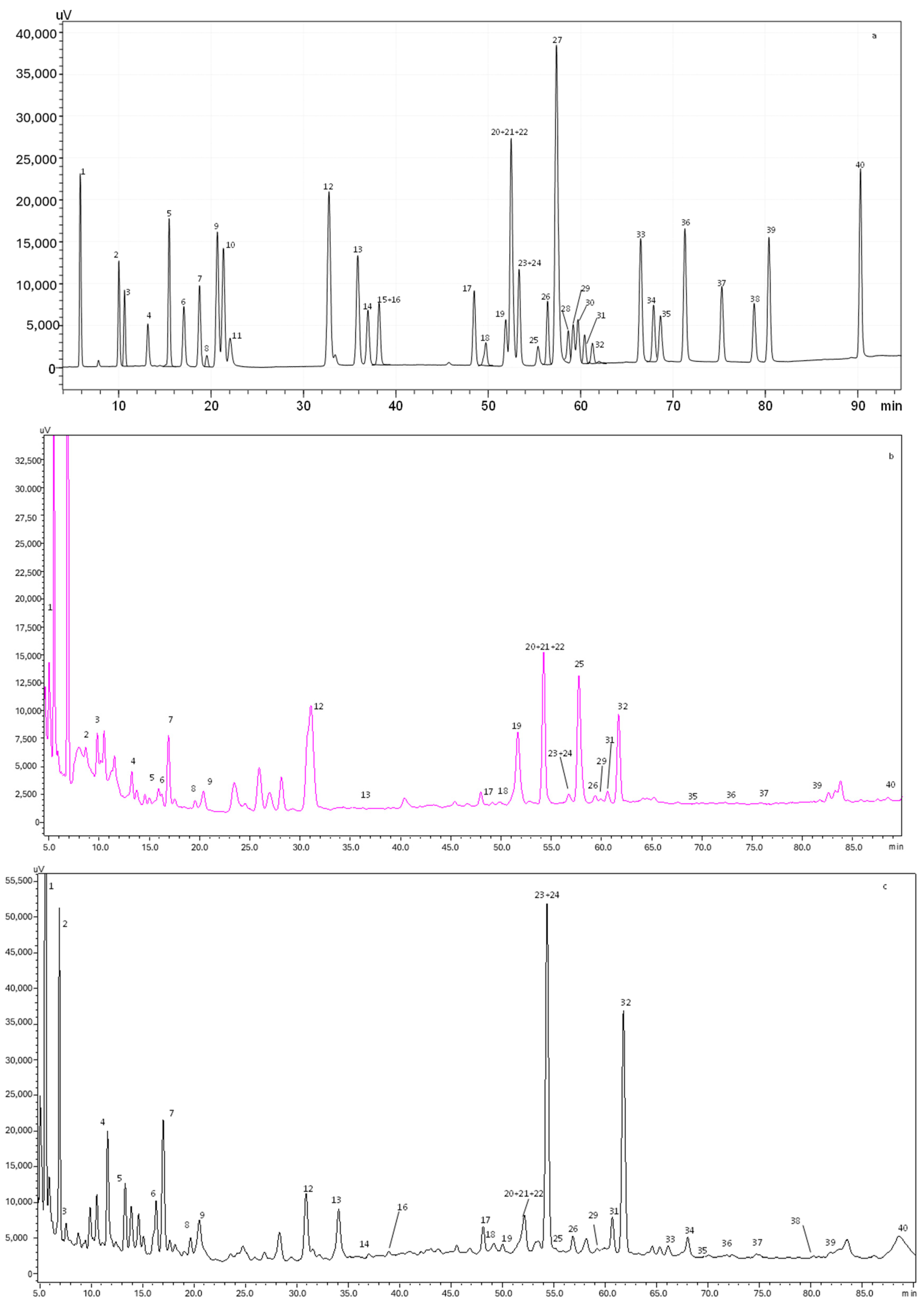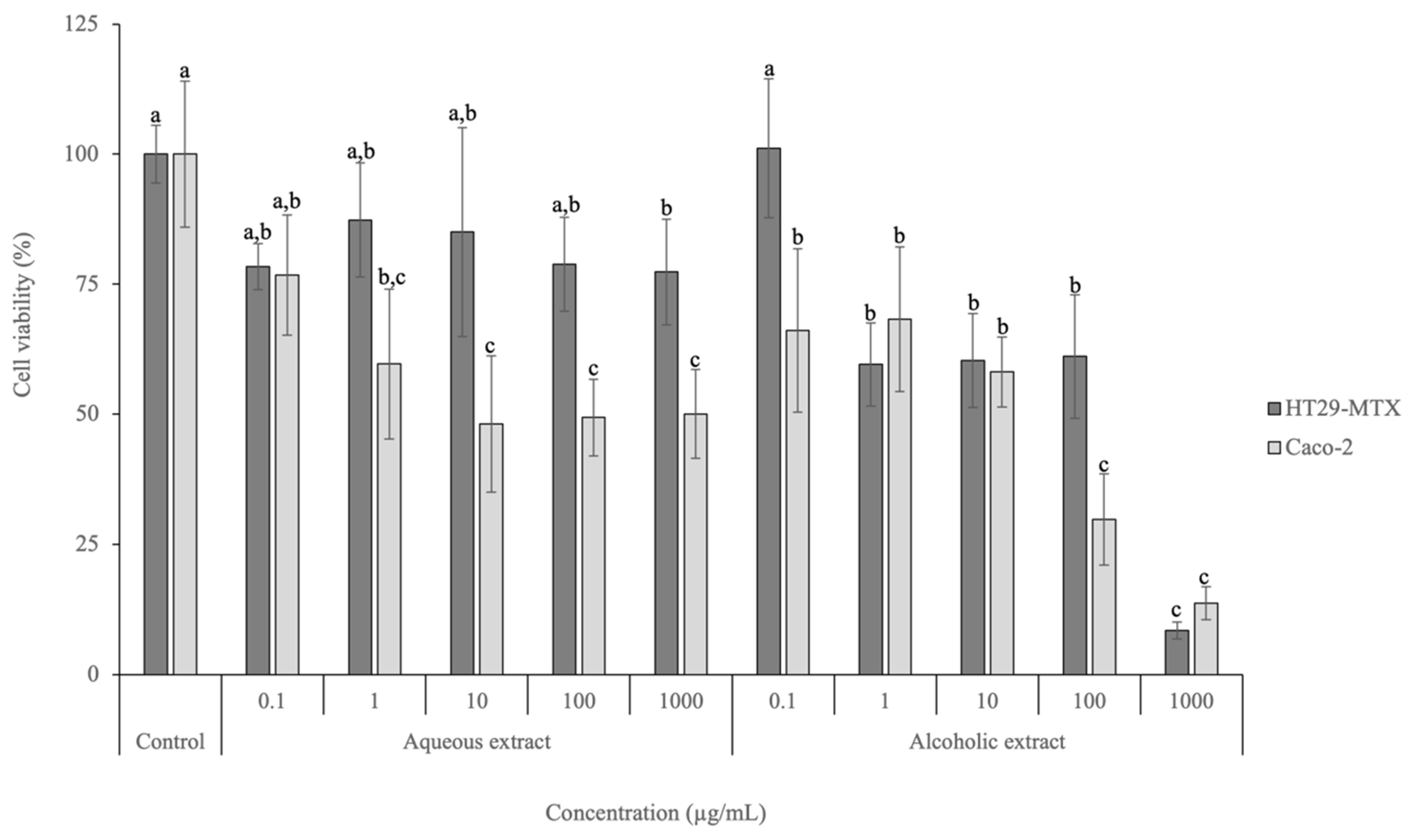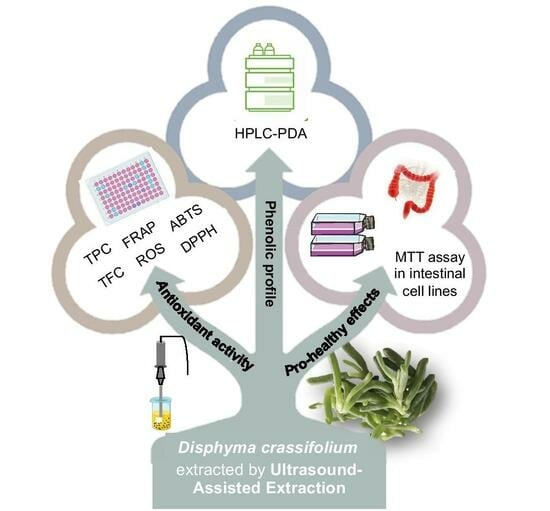Insights into the Bioactive Composition, Antioxidant Properties and In Vitro Cell Effects of Disphyma crassifolium
Abstract
1. Introduction
2. Materials and Methods
2.1. Chemicals
2.2. Samples
2.3. Extraction Procedure
2.4. Total Phenolic and Flavonoid Contents
2.5. In Vitro Antioxidant/Antiradical Activities
2.6. Reactive Oxygen Species Scavenging Capacity
2.6.1. Superoxide Radical Scavenging Capacity
2.6.2. Hypochlorous Acid Scavenging Capacity
2.6.3. Peroxyl Radical Scavenging Capacity
2.7. Phenolic Composition
2.8. Cell Viability Assays
2.9. Statistical Analysis
3. Results and Discussion
3.1. TPC, TFC, and In Vitro Antioxidant/Antiradical Activities
3.2. In Vitro Reactive Oxygen Species Scavenging Capacity
3.3. Identification and Quantification of Phenolic Compounds
3.4. In Vitro Cell Effects
4. Conclusions
Author Contributions
Funding
Institutional Review Board Statement
Informed Consent Statement
Data Availability Statement
Acknowledgments
Conflicts of Interest
References
- Lombardi, T.; Bertacchi, A.; Pistelli, L.; Pardossi, A.; Pecchia, S.; Toffanin, A.; Sanmartin, C. Biological and Agronomic Traits of the Main Halophytes Widespread in the Mediterranean Region as Potential New Vegetable Crops. Horticulturae 2022, 8, 195. [Google Scholar] [CrossRef]
- Giordano, R.; Saii, Z.; Fredsgaard, M.; Hulkko, L.S.S.; Poulsen, T.B.G.; Thomsen, M.E.; Henneberg, N.; Zucolotto, S.M.; Arendt-Nielsen, L.; Papenbrock, J.; et al. Pharmacological Insights into Halophyte Bioactive Extract Action on Anti-Inflammatory, Pain Relief and Antibiotics-Type Mechanisms. Molecules 2021, 26, 3140. [Google Scholar] [CrossRef]
- Barreira, L.; Resek, E.; Rodrigues, M.J.; Rocha, M.I.; Pereira, H.; Bandarra, N.; da Silva, M.M.; Varela, J.; Custódio, L. Halophytes: Gourmet food with nutritional health benefits? J. Food Compos. Anal. 2017, 59, 35–42. [Google Scholar] [CrossRef]
- Silva, A.M.; Lago, J.P.; Pinto, D.; Moreira, M.M.; Grosso, C.; Cruz Fernandes, V.; Delerue-Matos, C.; Rodrigues, F. Salicornia ramosissima Bioactive Composition and Safety: Eco-Friendly Extractions Approach (Microwave-Assisted Extraction vs. Conventional Maceration). Appl. Sci. 2021, 11, 4744. [Google Scholar] [CrossRef]
- Correia, A.; Silva, A.M.; Moreira, M.M.; Salazar, M.; Švarc-Gajić, J.; Brezo-Borjan, T.; Cádiz-Gurrea, M.D.L.L.; Carretero, A.S.; Loschi, F.; Dall’acqua, S.; et al. Salicornia ramosissima: A New Green Cosmetic Ingredient with Promising Skin Effects. Antioxidants 2022, 11, 2449. [Google Scholar] [CrossRef] [PubMed]
- Oueslati, S.; Ksouri, R.; Falleh, H.; Pichette, A.; Abdelly, C.; Legault, J. Phenolic content, antioxidant, anti-inflammatory and anticancer activities of the edible halophyte Suaeda fruticosa Forssk. Food Chem. 2012, 132, 943–947. [Google Scholar] [CrossRef]
- Costa, C.; Padalino, L.; Spinelli, S.; Serio, F.; Del Nobile Matteo, A.; Conte, A. Study of the efficacy of two extraction techniques from Crithmum maritimum and Salicornia europaea. J. Food Nutr. Res. 2018, 6, 456–463. [Google Scholar]
- Taljaard, S.; van Niekerk, L.; Adams, J.B.; Riddin, T. Advancing ecosystem accounting in estuaries: Swartkops Estuary case study. S. Afr. J. Sci. 2023, 119, 41. [Google Scholar] [CrossRef]
- RiaFresh. Sea Fingers. 2023. Available online: https://riafresh.com/en/produto/sea-fingers-2/ (accessed on 16 February 2024).
- Lameirão, F.; Pinto, D.; Vieira, E.F.; Peixoto, A.F.; Freire, C.; Sut, S.; Dall’acqua, S.; Costa, P.; Delerue-Matos, C.; Rodrigues, F. Green-sustainable recovery of phenolic and antioxidant compounds from industrial chestnut shells using ultrasound-assisted extraction: Optimization and evaluation of biological activities in vitro. Antioxidants 2020, 9, 267. [Google Scholar] [CrossRef]
- Silva, A.M.; Pinto, D.; Moreira, M.M.; Costa, P.C.; Delerue-Matos, C.; Rodrigues, F. Valorization of Kiwiberry Leaves Recovered by Ultrasound-Assisted Extraction for Skin Application: A Response Surface Methodology Approach. Antioxidants 2022, 11, 763. [Google Scholar] [CrossRef]
- Pinto, D.; Cádiz-Gurrea, M.D.L.L.; Garcia, J.; Saavedra, M.J.; Freitas, V.; Costa, P.; Sarmento, B.; Delerue-Matos, C.; Rodrigues, F. From soil to cosmetic industry: Validation of a new cosmetic ingredient extracted from chestnut shells. Sustain. Mater. Technol. 2021, 29, e00309. [Google Scholar] [CrossRef]
- Vilkhu, K.; Mawson, R.; Simons, L.; Bates, D. Applications and opportunities for ultrasound assisted extraction in the food industry—A review. Innov. Food Sci. Emerg. Technol. 2008, 9, 161–169. [Google Scholar] [CrossRef]
- Picó, Y. Ultrasound-assisted extraction for food and environmental samples. TrAC Trends Anal. Chem. 2013, 43, 84–99. [Google Scholar] [CrossRef]
- Singleton, V.L.; Orthofer, R.; Lamuela-Raventós, R.M. Analysis of total phenols and other oxidation substrates and antioxidants by means of folin-ciocalteu reagent. Methods Enzymol. 1999, 299, 152–178. [Google Scholar]
- Silva, A.M.; Luís, A.S.; Moreira, M.M.; Ferraz, R.; Brezo-Borjan, T.; Švarc-Gajić, J.; Costa, P.C.; Delerue-Matos, C.; Rodrigues, F. Influence of temperature on the subcritical water extraction of Actinidia arguta leaves: A screening of pro-healthy compounds. Sustain. Chem. Pharm. 2022, 25, 100593. [Google Scholar] [CrossRef]
- Pinto, D.; Vieira, E.F.; Peixoto, A.F.; Freire, C.; Freitas, V.; Costa, P.; Delerue-Matos, C.; Rodrigues, F. Optimizing the extraction of phenolic antioxidants from chestnut shells by subcritical water extraction using response surface methodology. Food Chem. 2021, 334, 127521. [Google Scholar] [CrossRef] [PubMed]
- Benzie, I.F.F.; Strain, J.J. Ferric reducing/antioxidant power assay: Direct measure of total antioxidant activity of biological fluids and modified version for simultaneous measurement of total antioxidant power and ascorbic acid concentration. Methods Enzymol. 1999, 299, 15–27. [Google Scholar]
- Barros, L.; Baptista, P.; Ferreira, I.C.F.R. Effect of Lactarius piperatus fruiting body maturity stage on antioxidant activity measured by several biochemical assays. Food Chem. Toxicol. 2007, 45, 1731–1737. [Google Scholar] [CrossRef]
- Re, R.; Pellegrini, N.; Proteggente, A.; Pannala, A.; Yang, M.; Rice-Evans, C. Antioxidant activity applying an improved ABTS radical cation decolorization assay. Free Radic. Biol. Med. 1999, 26, 1231–1237. [Google Scholar] [CrossRef]
- Gomes, A.; Fernandes, E.; Silva, A.M.S.; Santos, C.M.M.; Pinto, D.C.G.A.; Cavaleiro, J.A.S.; Lima, J.L.F.C. 2-Styrylchromones: Novel strong scavengers of reactive oxygen and nitrogen species. Bioorg. Med. Chem. 2007, 15, 6027–6036. [Google Scholar] [CrossRef]
- Ou, B.; Hampsch-Woodill, M.; Prior, R.L. Development and validation of an improved oxygen radical absorbance capacity assay using fluorescein as the fluorescent probe. J. Agric. Food Chem. 2001, 49, 4619–4626. [Google Scholar] [CrossRef]
- Moreira, M.M.; Barroso, M.F.; Boeykens, A.; Withouck, H.; Morais, S.; Delerue-Matos, C. Valorization of apple tree wood residues by polyphenols extraction: Comparison between conventional and microwave-assisted extraction. Ind. Crops Prod. 2017, 104, 210–220. [Google Scholar] [CrossRef]
- Pinto, D.; Reis, J.; Silva, A.M.; Salazar, M.; Dall’Acqua, S.; Delerue-Matos, C.; Rodrigues, F. Valorisation of Salicornia ramosissima biowaste by a green approach–An optimizing study using response surface methodology. Sustain. Chem. Pharm. 2021, 24, 100548. [Google Scholar] [CrossRef]
- Bao, M.; Lou, Y. Isorhamnetin prevent endothelial cell injuries from oxidized LDL via activation of p38MAPK. Eur. J. Pharmacol. 2006, 547, 22–30. [Google Scholar] [CrossRef] [PubMed]
- Badhani, B.; Sharma, N.; Kakkar, R. Gallic acid: A versatile antioxidant with promising therapeutic and industrial applications. Rsc Adv. 2015, 5, 27540–27557. [Google Scholar] [CrossRef]
- Sharifi-Rad, J.; Quispe, C.; Castillo, C.M.S.; Caroca, R.; Lazo-Vélez, M.A.; Antonyak, H.; Polishchuk, A.; Lysiuk, R.; Oliinyk, P.; De Masi, L. Ellagic acid: A review on its natural sources, chemical stability, and therapeutic potential. Oxidative Med. Cell. Longev. 2022, 2022, 3848084. [Google Scholar] [CrossRef]
- Wang, Z.H.; Kang, K.A.; Zhang, R.; Piao, M.J.; Jo, S.H.; Kim, J.S.; Kang, S.S.; Lee, J.S.; Park, D.H.; Hyun, J.W. Myricetin suppresses oxidative stress-induced cell damage via both direct and indirect antioxidant action. Environ. Toxicol. Pharmacol. 2010, 29, 12–18. [Google Scholar] [CrossRef]
- Khan, H.; Reale, M.; Ullah, H.; Sureda, A.; Tejada, S.; Wang, Y.; Zhang, Z.-J.; Xiao, J. Anti-cancer effects of polyphenols via targeting p53 signaling pathway: Updates and future directions. Biotechnol. Adv. 2020, 38, 107385. [Google Scholar] [CrossRef]
- Pei, J.; Velu, P.; Zareian, M.; Feng, Z.; Vijayalakshmi, A. Effects of Syringic Acid on Apoptosis, Inflammation, and AKT/mTOR Signaling Pathway in Gastric Cancer Cells. Front. Nutr. 2021, 8, 788929. [Google Scholar] [CrossRef]


| D. crassifolium Extracts | TPC (mg GAE/g dw) | TFC (mg CE/g dw) | FRAP (µmol FSE/g dw) | DPPH (% Inhibition) | ABTS (mg AAE/g dw) |
|---|---|---|---|---|---|
| Aqueous | 8.49 ± 0.31 | 8.02 ± 0.02 | 11.39 ± 0.56 | 10.13 ± 1.27 | 7.73 ± 0.97 |
| Alcoholic | 53.13 ± 8.54 * | 18.98 ± 1.34 * | 149.69 ± 6.79 * | 9.12 ± 0.77 | 9.37 ± 1.11 * |
| ROS | O2•− | HOCl | ROO |
|---|---|---|---|
| IC50 (µg/mL) | µmol TE/mg dw | ||
| D. crassifolium extracts | |||
| Aqueous | 172.46 ± 7.09 b | 10.48 ± 0.85 c | 0.08 ± 0.01 b |
| Alcoholic | NA | 1.97 ± 0.15 a | 0.34 ± 0.04 b |
| Positive controls | |||
| Gallic acid | 10.39 ± 1.60 a | 5.51 ± 0.34 b | 7.51 ± 0.40 b |
| Catechin | 26.24 ± 0.15 a | 0.32 ± 0.02 a | 237.11 ± 28.37 a |
| Compounds | Aqueous (mg/100g dw) | Alcoholic (mg/100g dw) |
|---|---|---|
| Phenolic acids | ||
| Gallic acid | 19.2 ± 1.0 | 184.4 ± 9.2 |
| Protocatechuic acid | 21.6 ± 1.1 | 84.4 ± 4.2 |
| Neochlorogenic acid | 4.7 ± 0.2 | 72.5 ± 3.6 |
| Vanillic acid | 3.3 ± 0.2 | 26.6 ± 1.3 |
| Caffeic acid | ND | ND |
| Syringic acid | ND | ND |
| Caftaric acid | 11.3 ± 0.6 | 14.4 ± 0.7 |
| Chlorogenic acid | 5.2 ± 0.3 | 159.7 ± 8.0 |
| 4-O-caffeyolquinic acid | 9.8 ± 0.5 | 211 ± 11 |
| p-Coumaric acid | 0.3 ± 0.0 | 118.7 ± 5.9 |
| Ferulic acid | ND | 10.5 ± 0.5 |
| Sinapic acid | ND | ND |
| 3.5-di-caffeoylquinic acid | 2.0 ± 0.1 | 33.4 ± 1.7 |
| Ellagic acid | 127.0 ± 6.3 | 5.2 ± 0.3 |
| 4.5-di-O-caffeoylquinic acid | 10.9 ± 0.5 | 8.1 ± 0.4 |
| Cinnamic acid | ND | ND |
| ∑Phenolic acids | 215.2 ± 10.8 | 929.1 ± 46.5 |
| Flavanols | ||
| Catechin | 33.1 ± 1.7 | 852.3 ± 42.6 |
| Epicatechin | 65.3 ± 3.3 | 132.0 ± 6.6 |
| ∑Flavanols | 98.5 ± 4.9 | 984.3 ± 49.2 |
| Flavanones | ||
| Naringin | 1.1 ± 0.1 | 85.4 ± 4.3 |
| Naringenin | ND | 72.3 ± 3.6 |
| ∑Flavanones | 1.1 ± 0.1 | 157.7 ± 7.9 |
| Flavonols | ||
| Quercetin-3-O-galactoside | 86.5 ± 4.3 | 435.8 ± 21.8 |
| Rutin | 0.9 ± 0.0 | 26.2 ± 1.3 |
| Myricetin | 106.6 ± 5.3 | 137.9 ± 6.9 |
| Kaempferol-3-O-glucoside | 6.6 ± 0.3 | 53.1 ± 2.7 |
| Kaempferol-3-O-rutinoside | 3.6 ± 0.2 | 9.4 ± 0.5 |
| Quercetin | 0.9 ± 0.0 | 17.4 ± 0.9 |
| Quercitrin | ND | ND |
| Tiliroside | 0.4 ± 0.0 | 27.1 ± 1.4 |
| Kaempferol | ND | 6.6 ± 0.3 |
| Quercetin-3-O-glucopyranoside | 0.4 ± 0.0 | 19.7 ± 1.0 |
| Isorhamnetin-3-O-glucoside | ND | ND |
| Isorhamnetin-3-O-rutinoside | 40.1 ± 2.0 | 879.5 ± 44.0 |
| ∑Flavonols | 245.9 ± 12.3 | 1612.6 ± 80.6 |
| Flavones | ||
| Apigenin | 1.0 ± 0.0 | 8.4 ± 0.4 |
| Chrysin | 1.4 ± 0.01 | 25.7 ± 1.3 |
| ∑Flavones | 2.3 ± 0.1 | 34.1 ± 1.7 |
| Others | ||
| Phloridzin | 59.7 ± 3.0 | 140.8 ± 7.0 |
| Phloretin | 0.2 ± 0.0 | 6.6 ± 0.3 |
| Resveratrol | 12.9 ± 0.6 | 1.2 ± 0.1 |
| trans-epsilon viniferin | ND | 4.1 ± 0.2 |
| Caffeine | 3.32 ± 0.2 | 273.8 ± 13.7 |
| trans-polydatin | ND | 6.1 ± 0.3 |
| ∑Others | 76.1 ± 3.8 | 432.6 ± 21.6 |
| ∑TOTAL | 639.2 ± 32.0 | 4150.4 ± 207.5 |
Disclaimer/Publisher’s Note: The statements, opinions and data contained in all publications are solely those of the individual author(s) and contributor(s) and not of MDPI and/or the editor(s). MDPI and/or the editor(s) disclaim responsibility for any injury to people or property resulting from any ideas, methods, instructions or products referred to in the content. |
© 2024 by the authors. Licensee MDPI, Basel, Switzerland. This article is an open access article distributed under the terms and conditions of the Creative Commons Attribution (CC BY) license (https://creativecommons.org/licenses/by/4.0/).
Share and Cite
Silva, A.M.; Moreira, M.M.; Teixeira, F.; Ferraz, R.; Salazar, M.; Delerue-Matos, C.; Rodrigues, F. Insights into the Bioactive Composition, Antioxidant Properties and In Vitro Cell Effects of Disphyma crassifolium. Foods 2024, 13, 1219. https://doi.org/10.3390/foods13081219
Silva AM, Moreira MM, Teixeira F, Ferraz R, Salazar M, Delerue-Matos C, Rodrigues F. Insights into the Bioactive Composition, Antioxidant Properties and In Vitro Cell Effects of Disphyma crassifolium. Foods. 2024; 13(8):1219. https://doi.org/10.3390/foods13081219
Chicago/Turabian StyleSilva, Ana Margarida, Manuela M. Moreira, Filipa Teixeira, Ricardo Ferraz, Miguel Salazar, Cristina Delerue-Matos, and Francisca Rodrigues. 2024. "Insights into the Bioactive Composition, Antioxidant Properties and In Vitro Cell Effects of Disphyma crassifolium" Foods 13, no. 8: 1219. https://doi.org/10.3390/foods13081219
APA StyleSilva, A. M., Moreira, M. M., Teixeira, F., Ferraz, R., Salazar, M., Delerue-Matos, C., & Rodrigues, F. (2024). Insights into the Bioactive Composition, Antioxidant Properties and In Vitro Cell Effects of Disphyma crassifolium. Foods, 13(8), 1219. https://doi.org/10.3390/foods13081219












